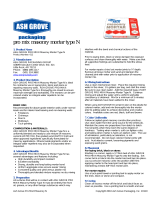Page is loading ...

A completed wall.
How to Lay Brick
Whether you are laying brick to build a mail box enclosure, or building a
brick house, the process is the same. Paying attention to basic principles
will help you succeed with your project.
Gather all the materials you need to start your project before beginning. When you
have mixed the masonry cement and started laying brick, you have to use the mortar up and
strike your joints before quitting.
Pour a concrete foundation if you do not have an existing slab, brickledge, or footing
to work on. This must be level and below the grade of the finished ground so that the brick is
all you see when your wall is finished.
Layout the wall you are going to work on, and mark openings like doors, windows, and
any architectural appertanances you are including in your design. For beginners, a
simple, square project like a planter box or mail box pedestal is best.
Place brick along the length of your foundation in stacks you can reach easily from
your work area.
Space "mortar boards" about every six feet along the wall, or on each side if the
project is small. This will allow you to grab mortar with your trowel as you work, and not have
to move around too much.
Mix your masonry cement, or mortar. This can be done in a wheelbarrow for small projects,
or a mortar box if you don't have access to a mortar mixer or cement mixer. Basically, to mix
the mortar, you will use a ratio of three parts masonry sand (builders sand, if it is very clean),
to one part masonry cement. Add water to the dry materials and mix to a consistancy like
pudding. Too dry, and it will be difficult to "set" the brick in the mortar bed, too wet and the brick
will sag.
Place a few shovels of mortar on each board, splashing the board first with water so
the mortar "keeps", or stays wet enough to use.
Steps
How to Lay Brick: 14 steps - wikiHow
http://www.wikihow.com/index.php?title=Lay-Brick&printable=yes
1 of 4
9/11/2012 11:45 AM

10
12
13
14
Start at a corner, and using the trowel, scoop up mortar and place a 4 to 6 inch wide
band on the footing or slab about 1 inch thick. Set a brick down in this "bed" of mortar, and
tap it down with the handle of your trowel, until it is level, parallel to the line of your wall, and
the edge is plumb. Repeat with 6 or 8 brick, using the edge of the trowel to cut away the
excess mortar that is shoved out from under the brick as you go.
Set another course of brick, starting at the corner, on top of the first course. If you are
turning the corner you began at, you will set each course half a brick back from the previous
course, so that each course is staggered half a brick. If you are turning the corner where you
began, put the first brick in the first course so that it is square, and lay a few brick in this
direction also.
Keep the height of the brick the same using a spirit or carpenter's level, and keep the
end joints (head joints) equal. The standard bed and head joints are 3/8 inch, but this can
be adjusted to your preference, up to 3/4 inch or even more.
Lay up several courses on each end of the wall you are going to lay first, these are the
"leads", then you can attach a piece of builder's line at the top of each brick as you lay
up the remaining brick in this wall, keeping them aligned and level.
Strike the head and bed joints with a "jointer" or "joint striker" when the mortar has
begun to set. The jointer is a piece of tubing whose diameter is the same or slightly larger
than your joint spacing, bent in an "S" shape. Hold the tool on one end, and rub it along the
mortar joint between your brick with the curved portion of the tool to smooth out the mortar
joint.
Brush the face of the brick with a "foxtail" brush to wipe away excess mortar and
finish smoothing the joint. It takes a lot of practice to be able to tell when the mortar is set
properly to strike and brush the joints, but basically, when it is hard enough to touch with your
finger and not leave an impression, it is ready.
Continue laying the brick until you are level with the leads you laid up, then begin at
the ends or corners laying either in another direction, or straight up with another lead.
Video
How to Lay Brick: 14 steps - wikiHow
http://www.wikihow.com/index.php?title=Lay-Brick&printable=yes
2 of 4
9/11/2012 11:45 AM

Have a clearly marked out area to lay the bricks in.
Mortar mix should be cleaned off skin if you come in contact with it. It contains lime, a caustic
chemical which can cause burns with prolonged exposure.
Do not breathe dust when mixing or handling dry ingredients.
Wear safety glasses.
Use the proper tools and techniques when cutting brick.
Mortar
Masonry Sand
Bricks
Plywood for mortar boards
Shovel
Level
Trowel
Mortar hoe for mixing
Water source
Tips
Warnings
Things You'll Need
How to Lay Brick: 14 steps - wikiHow
http://www.wikihow.com/index.php?title=Lay-Brick&printable=yes
3 of 4
9/11/2012 11:45 AM

Foxtail brush
Pointing tool or joining
How to Replace a Broken Fence Post
How to Prepare for a Home Improvement Project
How to Build a Brick Wall
How to Build a Temporary Brick Barbecue
How to Create an Awesome Lego Brick Model
http://www.motherearthnews.com/DIY/1998-10-01/Bricklaying-for-the-Do-It-Yourselfer.aspx
http://www.homesite.com.au/outdoors/paving-and-decking/projects-diy/diy-bricklaying
Related wikiHows
Sources and Citations
How to Lay Brick: 14 steps - wikiHow
http://www.wikihow.com/index.php?title=Lay-Brick&printable=yes
4 of 4
9/11/2012 11:45 AM
/





